A New Plugging Technology and Its Application for the Extensively Collapsed Ore Pass in the Non-Empty Condition
Abstract
:1. Introduction
2. Construction of Structure-Plugging System for the Extensively Collapsed Long Ore Pass in the Non-Empty Condition
3. Integration of Plugging Technology for the Extensively Collapsed Long Ore Pass in the Non-Empty Condition
- Stability evaluation of the structure-plugging system.
- Drilling in the composite rock mass from hard rock to loose rock mass.
- How to achieve full grouting to the bulk and loose rock mass in the plugging area.
- How to ensure that grout does not block the lower part of the plugging area.
3.1. Stability Evaluation Method of the Plugging Structure
3.2. Controlled Technology of Drilling with Casing in the Composite Rock Mass
3.2.1. A Technology to Solve Sticking in the Interface between Hard Rock and Loose Rock Mass
3.2.2. A Technology to Effectively Reduce the Frequency of Broken Casing during a Long-Distance Process of the Drilling of Casing
3.3. Controllable Grouting Technology for the Inhomogeneous Loose Rock Mass
- (i)
- Grouting for the inhomogeneous loose rock mass as tightly as possible in the plugging area;
- (ii)
- Ensuring that grout will not block the incline ore pass and the part of ore pass below the plugging area so that subsequent use can be restored as soon as possible.
3.3.1. Diffusion Characteristics of Cement–Silicate Grout in the Loose Rock Mass
3.3.2. Grouting Method
4. Engineering Application
4.1. Background
4.2. Design and Construction
- Gravity stress.
- Janssen formula.
- Recommended method from the “Code for design of reinforced concrete silos”.
- Recommended method from the Japanese Ore Pass Committee.
- Recommended method from the “Mine Design Manual”.
- a.
- Waste rock replacement
- b.
- Composite bar combined casing with prestressed cable
- c.
- Controllable grouting of C–S grout
4.3. Effect
5. Conclusions
- Aiming at a relatively difficult problem such as plugging for the extensively collapsed long ore pass, some simple fundamentals in our daily life such as plug effect, suspension effect, arch effect, and span-reducing effect are ingeniously combined together and used for the design of the plugging structure. It can be seen that one of the above effects plays a role of little importance in the plugging design; however, the combination of the above effects shows great power to solve extraordinary difficulty.
- A new composite bar combined casing with prestressed cable is created and used in the permanent plugging structure, which includes a series of improvements such as holes and grout vents in the casing body. Meanwhile, an attempt that uses C–S grout for loose rock mass has been finished successfully, in which diffusion characteristics of the C–S grout and grouting method are elaborated in detail.
- Although this structure-plugging system and its key technology has been used successfully in the case of the Xingshan Iron Mine in China, whether the design concept is optimized is still worthy of discussing. Hang-up phenomena often happen in many large ore passes, and this situation seems to occur easily and frequently because several blocks could remain stable enough to bear vertical pressure for a long time. So, some considerations and efforts should be gradually taken and optimized to near the hang-up state in the plugging design in the future.
6. Patents
Author Contributions
Funding
Acknowledgments
Conflicts of Interest
References
- Gardner, L.J.; Fernandes, N.D. Ore pass rehabilitation–case studies from impala platinum limited. J. S. Afr. Inst. Min. Met. 2006, 106, 17–23. [Google Scholar]
- Yu, S.B.; Being General Research Institue of Mining & Metallurgy, Beijing, China; Yuan, Y.; Being General Research Institue of Mining & Metallurgy, Beijing, China. Research on a key technique of pluging of main ore pass in Xingshan Irion Mine. Personal communication, 2016. [Google Scholar]
- Guo, C.; Xu, S.L. Exploration and practice of the landslide area solution at −330 m level ore dumping chamber and the main ore pass in Xingshan iron ore mine. Chin. Min. 2017, 26, 171–174. [Google Scholar]
- Gao, Y.T.; Wang, J.; Song, W.D.; Wu, S.C. A new technique—Supporting funnel method used in recovering and controlling of large-scale collapsed main ransportation shaft. Chin. J. Rock Mech. Eng. 2002, 22, 540–545. [Google Scholar]
- Hadjigeorgiou, J.; Lessard, J.F. Numerical investigations of ore pass hang-up phenomena. Int. J. Rock Mech. Min. Sci. 2007, 44, 820–834. [Google Scholar] [CrossRef]
- Hadjigeorgiou, J.; Lessard, J.F. Strategies for restoring material flow in ore and waste pass systems. Int. J. Min. Reclam. Environ. 2010, 24, 267–282. [Google Scholar] [CrossRef]
- Thanh, V.; Yang, H.W.; Adrian, R.R. Cohesion and suction induced hang-up in ore passes. Int. J. Rock Mech. Min. Sci. 2016, 87, 113–128. [Google Scholar]
- Hadjigeorgiou, J.; Mercier-Langevin, F. Estimating ore pass longevity in hard rock mines. In Proceedings of the 42nd US Rock Mechanics Symposium, San Francisco, CA, USA, 29 June–2 July 2008. [Google Scholar]
- Clegg, I.D.; Hanson, D.S. Ore pass design and support at Falconbridge Limited. In Proceedings of the International Symposium on Rock Support, Sudbury, ON, Canada, 16–19 June 1992. [Google Scholar]
- Hadjigeorgiou, J.; Esmaieli, K. Selecting ore pass–finger raise configurations in underground mines. Rock Mech. Rock Eng. 2011, 44, 291–303. [Google Scholar]
- Hadjigeorgiou, J.; Lessard, J.F.; Mercier-Langevin, F. Ore pass practice in Canadian mines. J. S. Afr. Inst. Min. Met. 2005, 105, 809–816. [Google Scholar]
- Luo, Z.Q.; Chen, J.; Xie, C.Y.; Wang, W.; Liu, X.M. Mechanism of impact-induced damage of main ore pass and its experimental validation. Rock Soil Mech. 2015, 36, 1744–1751. [Google Scholar]
- Esmaieli, K.; Hadjigeorgiou, J.; Grenon, M. Stability analysis of the 19A ore pass at Brunswick mine using a two-stage numerical modeling approach. Rock Mech. Rock Eng. 2013, 46, 1323–1338. [Google Scholar] [CrossRef]
- Song, W.D.; Wang, H.Y.; Wang, X.; Wang, W.; Du, J.H. Theoretical analysis and test of impact load due to ore dumping in chute. Rock Soil Mech. 2011, 32, 326–332. [Google Scholar]
- Zhao, Y.; Ye, H.W.; Lei, T.; Wang, C.; Wang, Q.Z.; Long, M. Theoretical study of damage characteristics on ore pass wall based on the erosion-wearing theory. Chin. J. Rock Mech. Eng. 2017, 36, 4002–4007. [Google Scholar]
- Li, C.H.; Cai, M.F.; Qiao, L.; Ji, H.G.; Liu, G.F.; Wang, J.B.; Zhao, K.G.; Liu, Y.S. Engineering design and construction effect of reinforcement measures of main ore pass. Mine Constr. Tech. 1999, 20, 21–23. [Google Scholar]
- Alex, M.R.; Verne, M.; Sanjay, N.; Ting, R. Experimental and numerical investigation of high-yield grout ore pass plugs to resist impact loads. Int. J. Rock Mech. Min. Sci. 2014, 70, 1–15. [Google Scholar]
- Carr, C.J.; Krause, L.E. Ore pass and chute maintenance at Xstrata–Mount Isa Copper Operations. In Proceedings of the 9th AusIMM Underground Operators’ Conference, Perth, Australia, 7–9 March 2005. [Google Scholar]
- Jin, C.Y.; Jin, Q.; Jiang, Q. Pressure variation at ore pass bottom during ore drawing process. J. Northeast. Univ. Nat. Sci. 2012, 33, 887–890. [Google Scholar]
- China Coal Construction Association. Code for Design of Reinforced Congcrete Silos, GB50077-2003; China Planning Press: Beijing, China, 2004; pp. 15–20. ISBN 1580058-543. [Google Scholar]
- Di, M.K. Research on ore movement in ore pass draft (two eights). Foreign Met. Mine 1990, 9, 35–39. [Google Scholar]
- Yu, S.B.; Chen, H.; Cao, H.; Yuan, Y.; Zhao, J.Z.; Guo, C. Analysis and engineering application of blocking pressure of ore pass. Chin. Min. Mag. 2016, 25, 299–302. [Google Scholar]
- Wang, Y.M. Modern Mine Manual, 1st ed.; Metallurgical Industry Press: Beijing, China, 2011; pp. 600–605. ISBN 978-7-5024-5567-5. [Google Scholar]
- Yu, S.B.; Yang, X.C.; Dong, K.C.; Xie, L.K.; Sun, X.M.; Guo, L.J. Space-time rule of the control action of filling body for the movement of surrounding rock in method of the delayed filling open stoping. J. Min. Saf. Eng. 2014, 31, 430–434. [Google Scholar]
- Evert, H.; Antonio, K. Rock-mass properties for surface mines. In Slope Stability in Surface Mining; William, A.H., Michael, K.M., Dirk, J.A., Van, Z., Eds.; Society for Mining, Metallurgy, and Exploration, Inc.: Littleton, CO, USA, 2009; pp. 59–67. ISBN 978-0-87335-295-6. [Google Scholar]
- Cai, M.F. Mechanics and Engineering of Rock, 1st ed.; Science Press: Beijing, China, 2002; pp. 104–108. ISBN 978-7-03-010470-0. [Google Scholar]
- Ministry of Construction of the People’s Republic of China. Code for Design of Steel Structures, GB50017-2003; China Planning Press: Beijing, China, 2003; pp. 8–10. ISBN 1580058-536.
- Evert, H. Rock mass properties for underground mines. In Underground Mining Methods–Engineering Fundamentals and International Case Studies; William, A.H., Richard, L.B., Eds.; Society for Mining, Metallurgy, and Exploration, Inc.: Littleton, CO, USA, 2001; pp. 467–474. ISBN 0-87335-193-2. [Google Scholar]
- Zhou, X.; Gao, G.R. Grouting Construction Manual, 1st ed.; China Coal Industry Press: Beijing, China, 2014; pp. 52–58. ISBN 978-7-5020-4405-3. [Google Scholar]
- Ma, G.Y.; Chang, Z.H. Theory and Practice of Grouting Drainage and Anchorage of Rock Mass, 1st ed.; China Water Publisher: Beijing, China, 2003; pp. 64–71. ISBN 7-5084-1458-6. [Google Scholar]
- Ruan, W.J. Spreading model of grouting in rock mass fissures based on time-dependent behavior of viscosity of cement-based grouts. Chin. J. Rock Mech. Eng. 2005, 24, 2709–2714. [Google Scholar]
- Li, S.C.; Liu, R.T.; Zhang, Q.S.; Sun, Z.Z.; Zhang, X.; Zhu, M.T. Research on C-S slurry diffusion mechanism with time-dependent behavior of viscosity. Chin. J. Rock Mech. Eng. 2013, 32, 2415–2421. [Google Scholar]
- Zhang, F.M.; Pan, X.; Chang, L.Y. Mine Design Manual; Sinking and Driving Engineering Volume; China Architecture & Building Press: Beijing, China, 1989; pp. 536–537. ISBN 7-112-00445-4/TD-5. [Google Scholar]
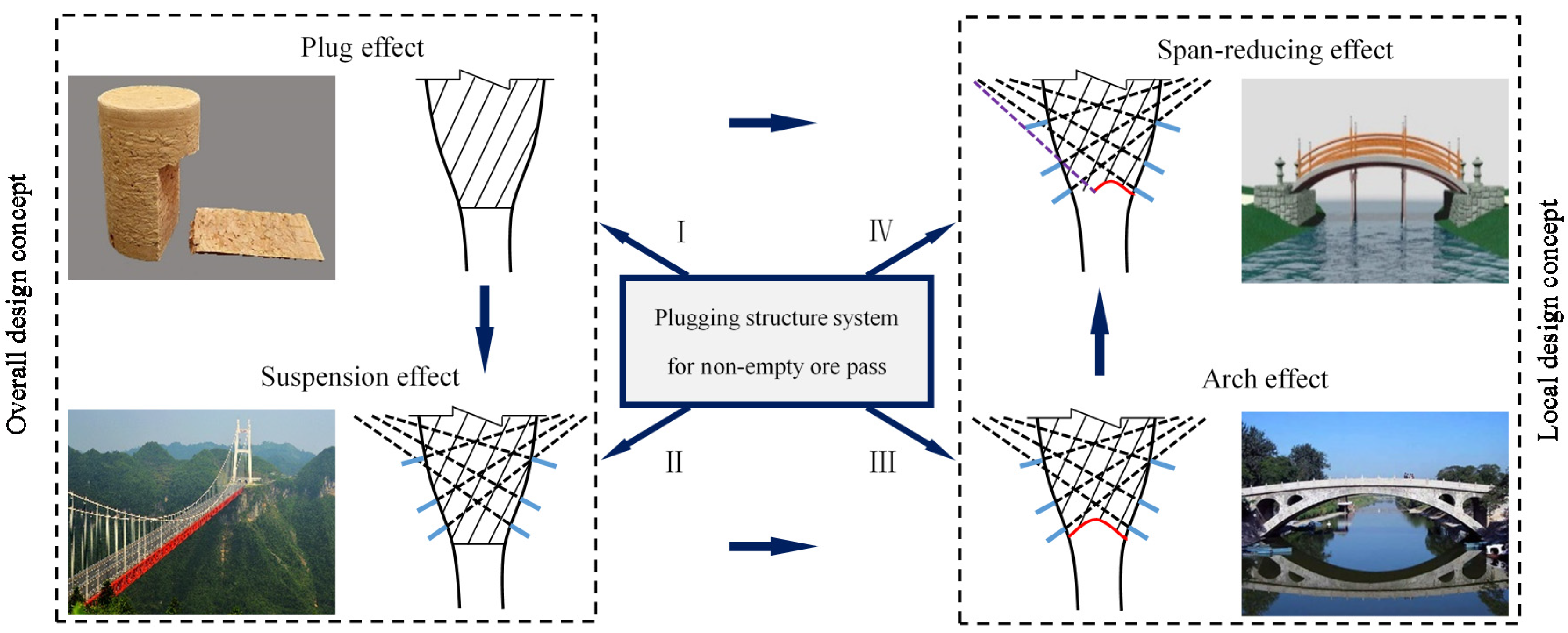
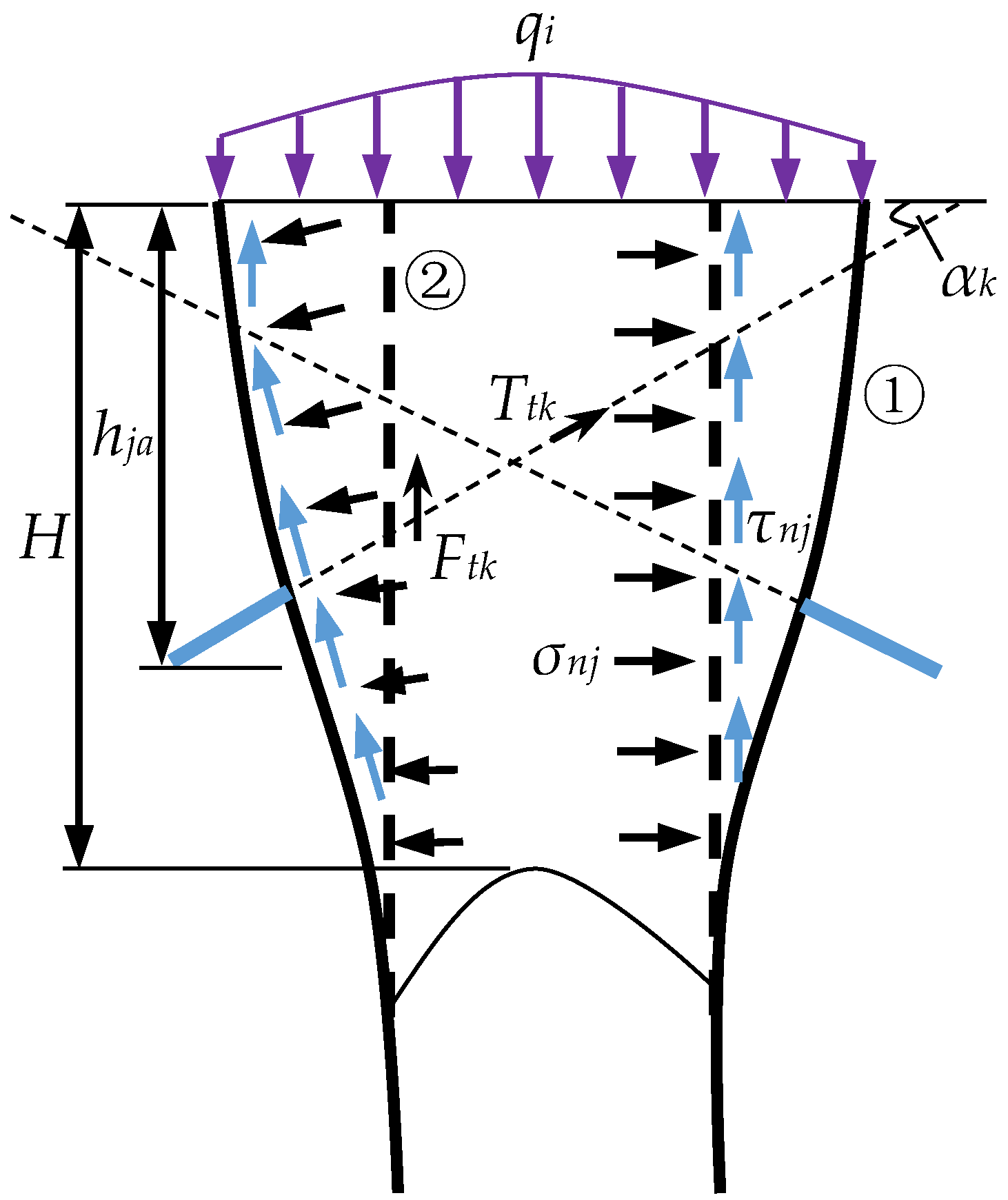
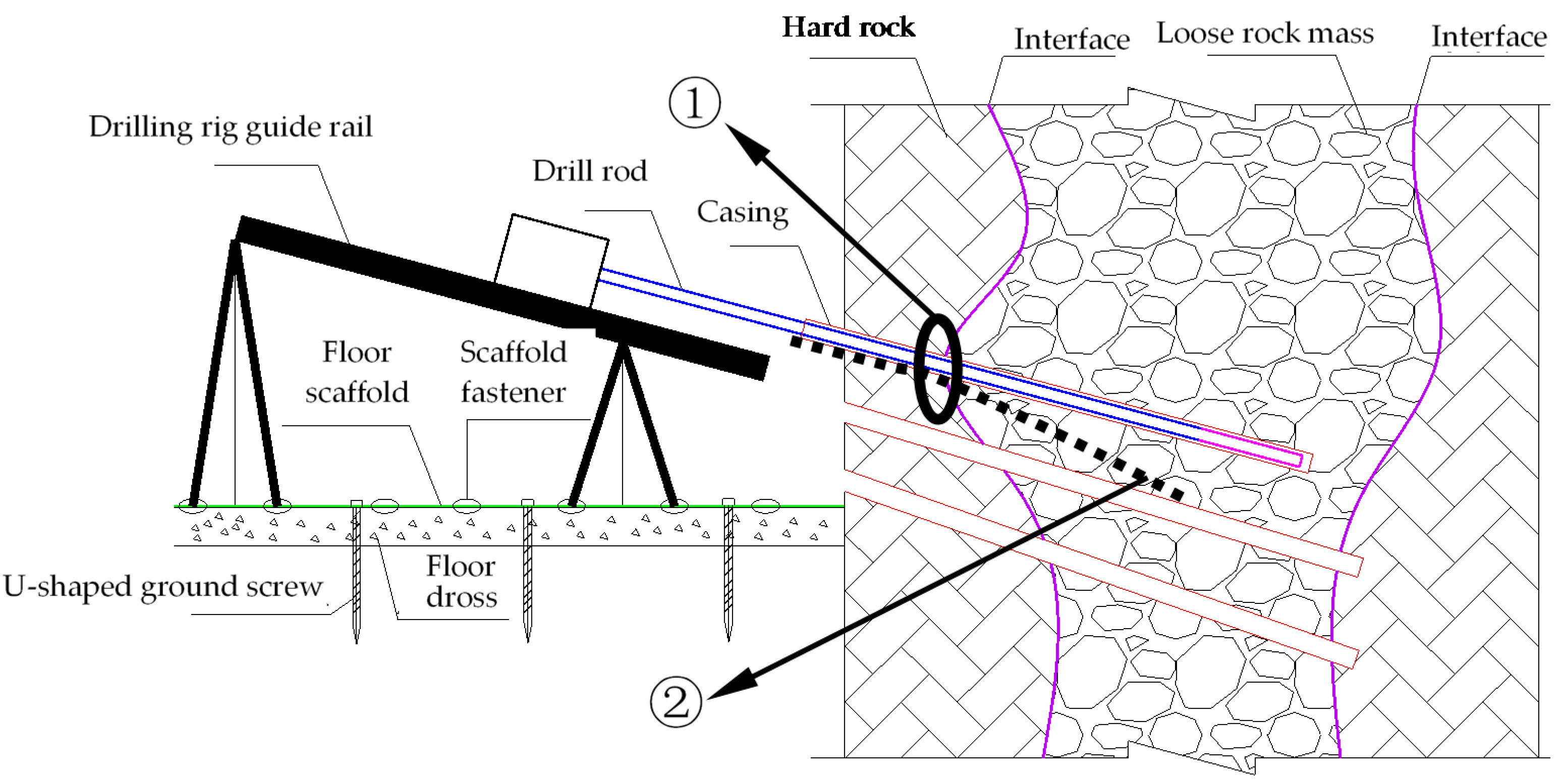

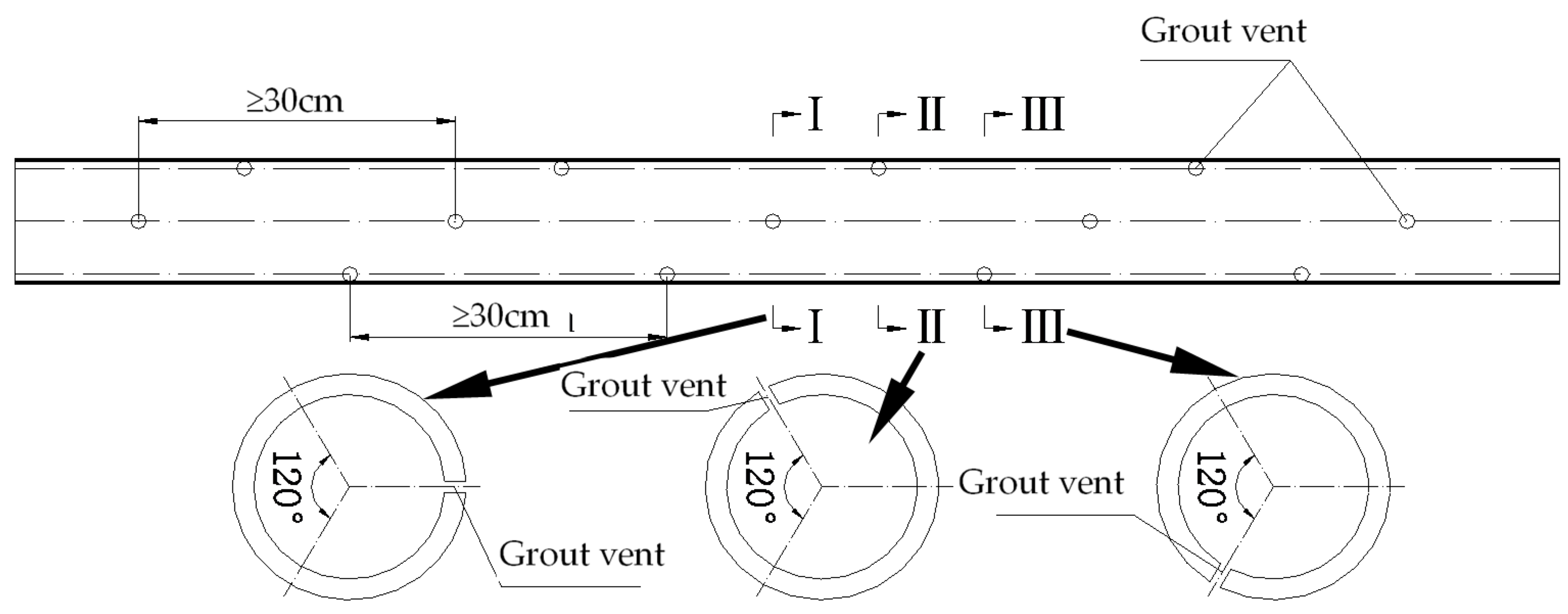
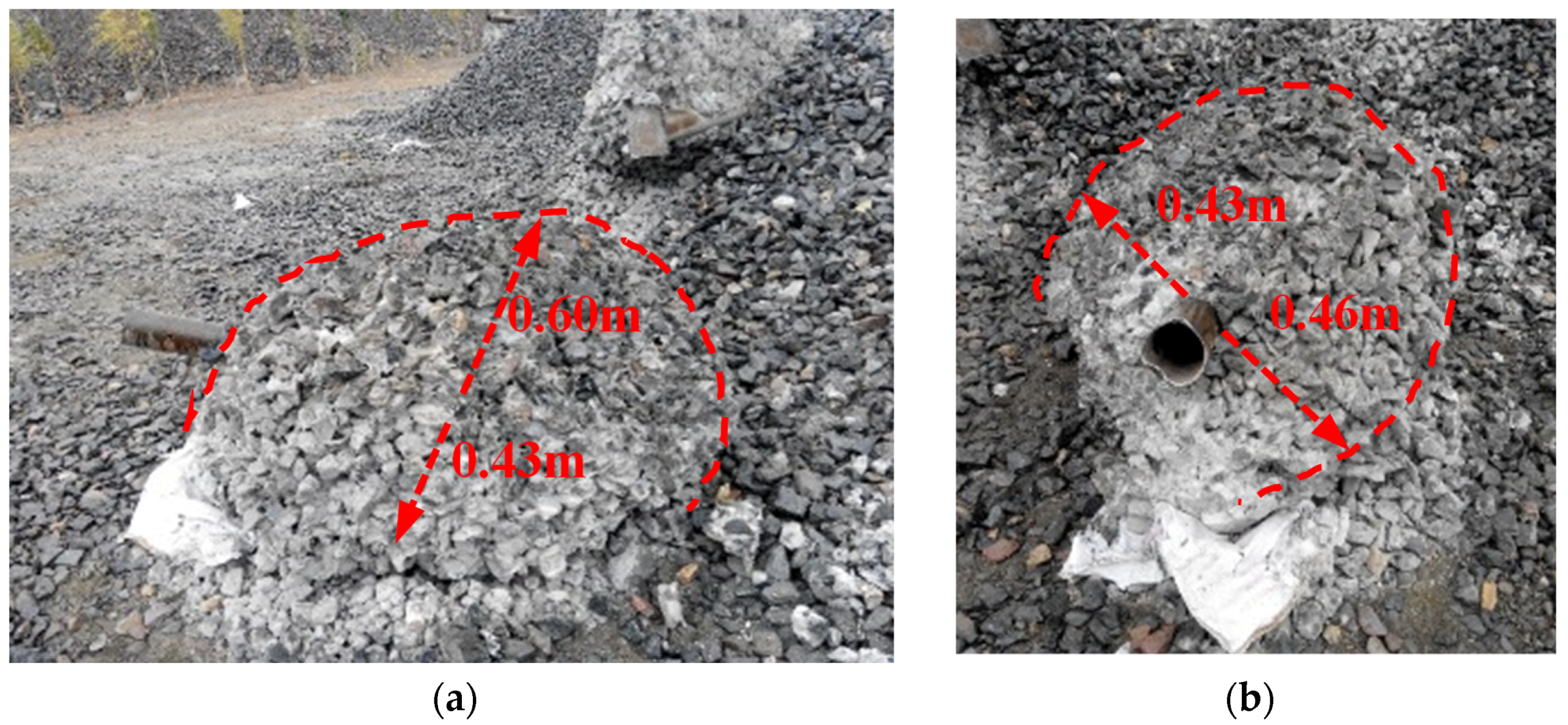
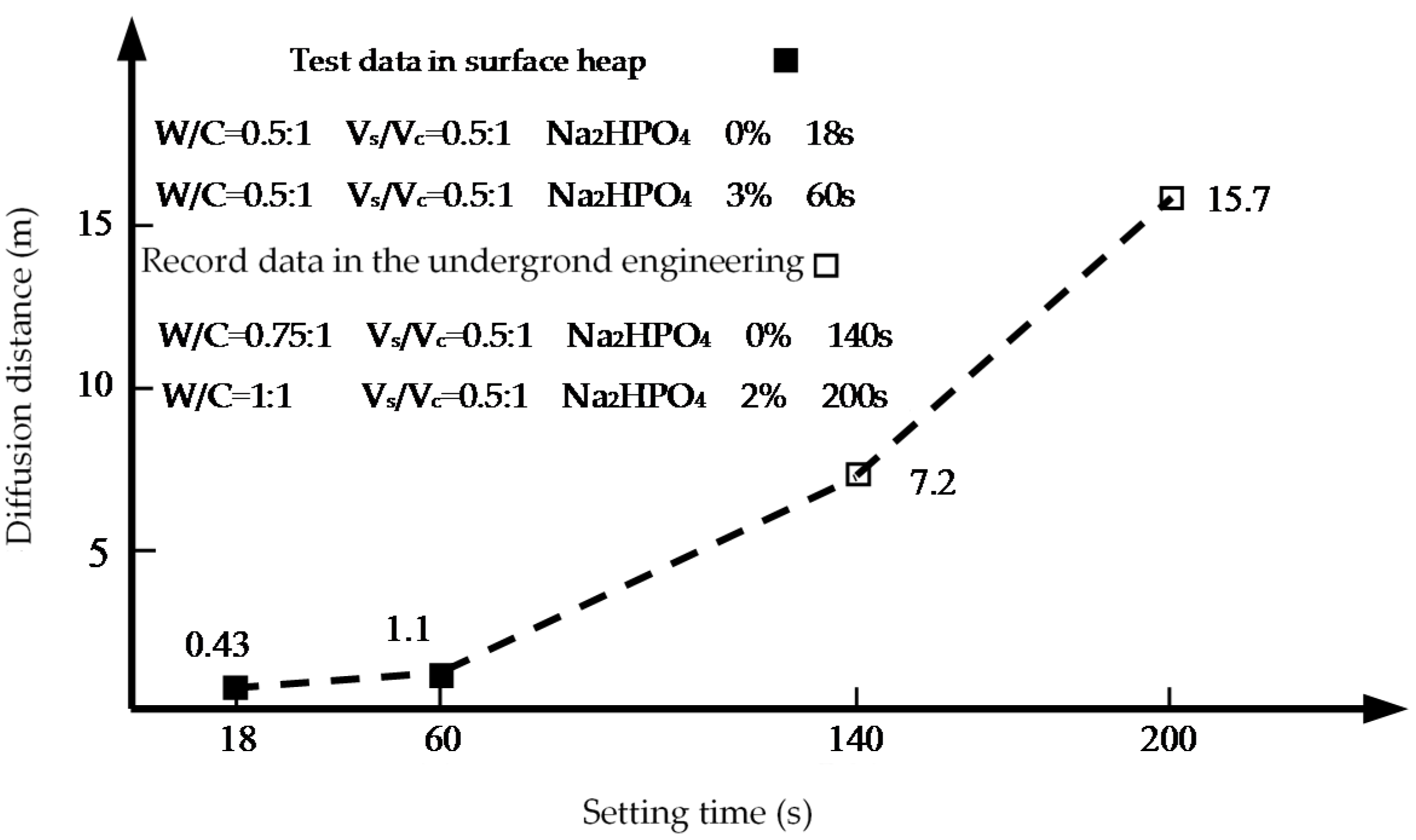
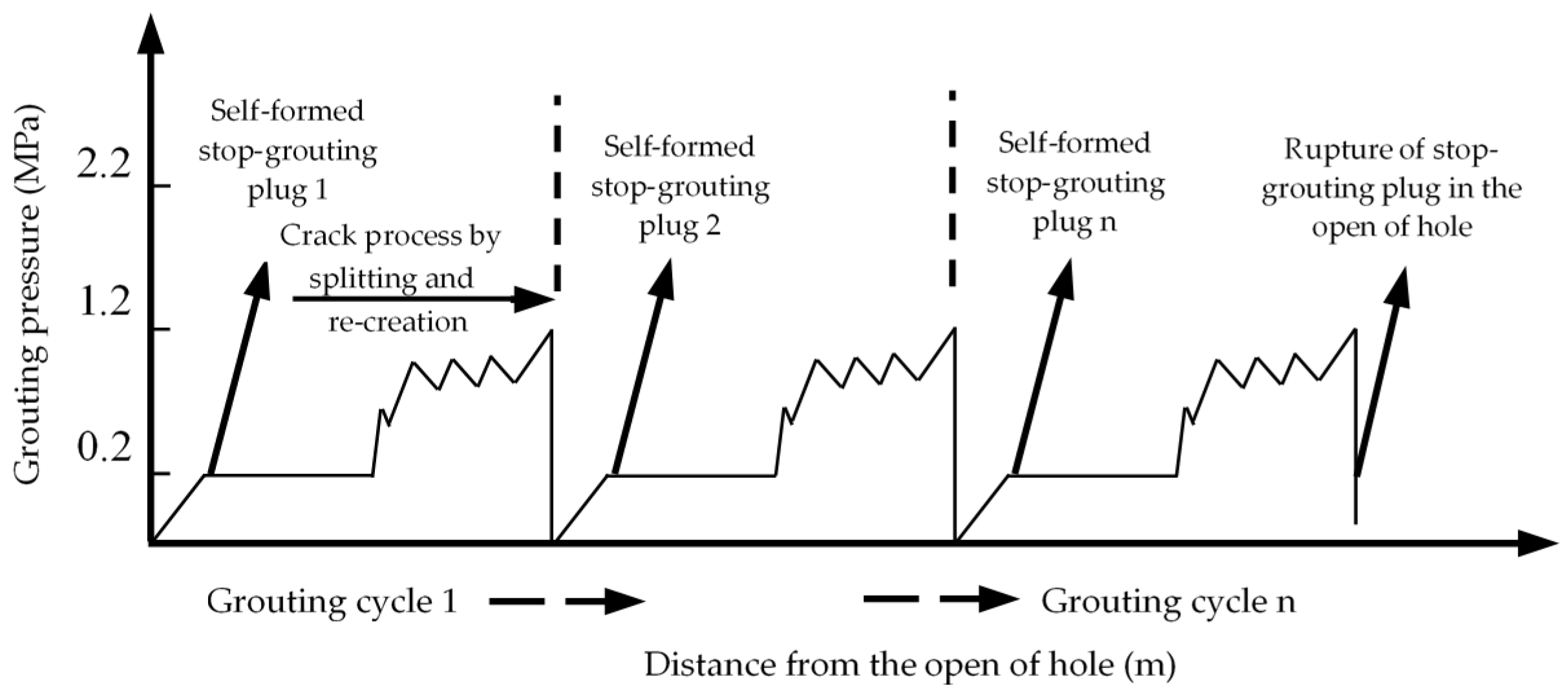

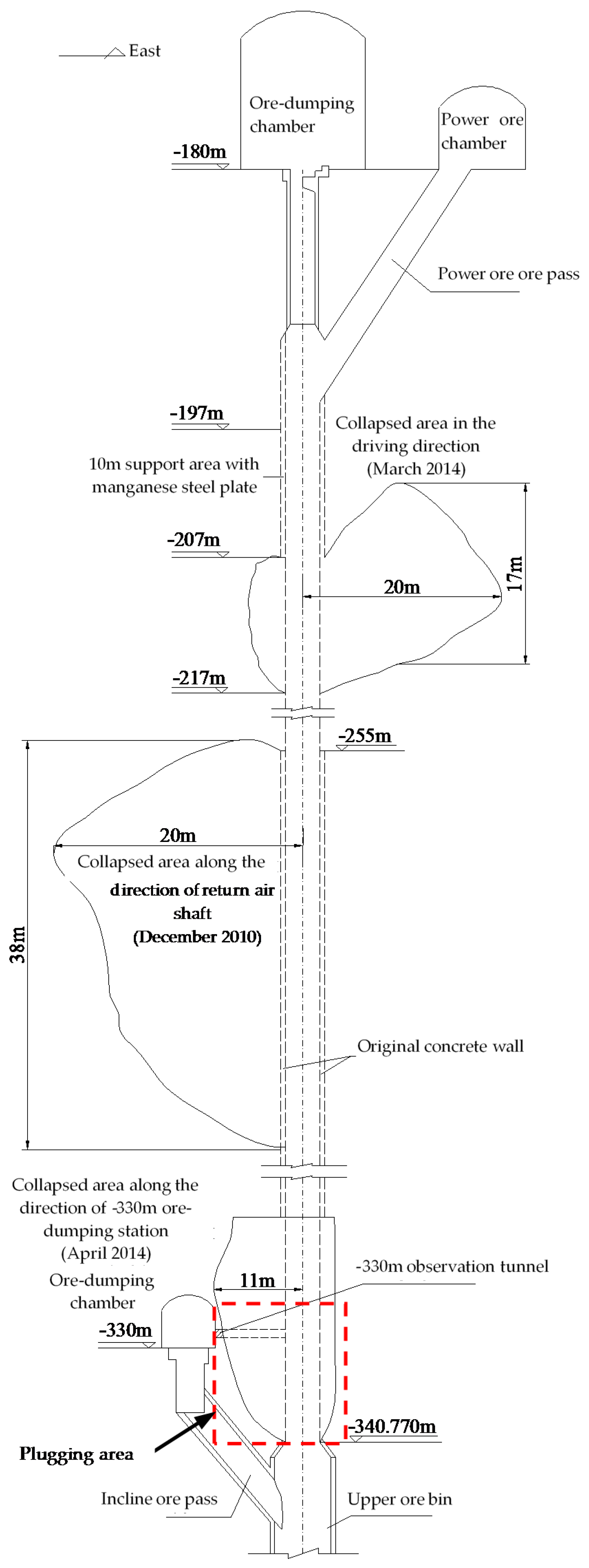
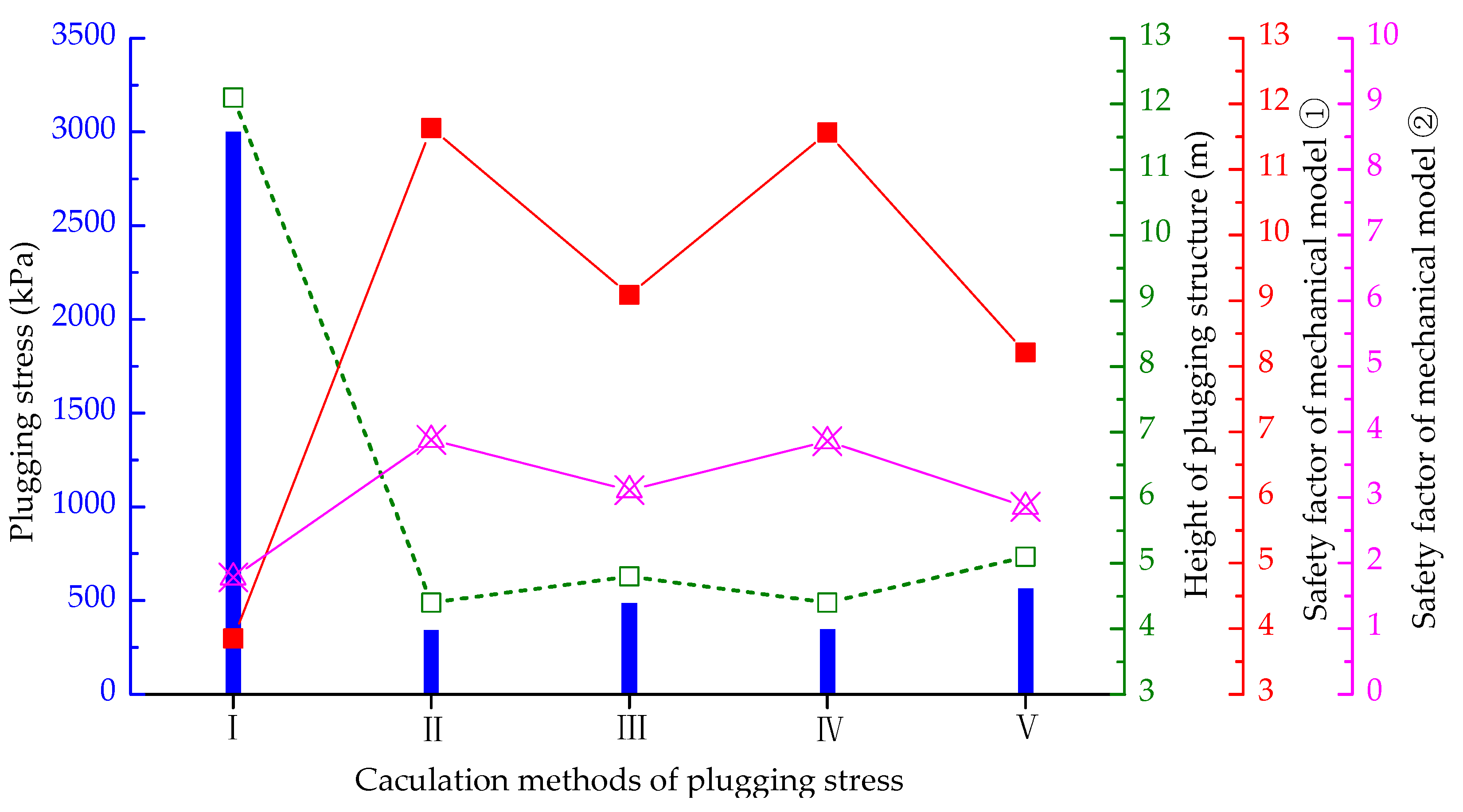
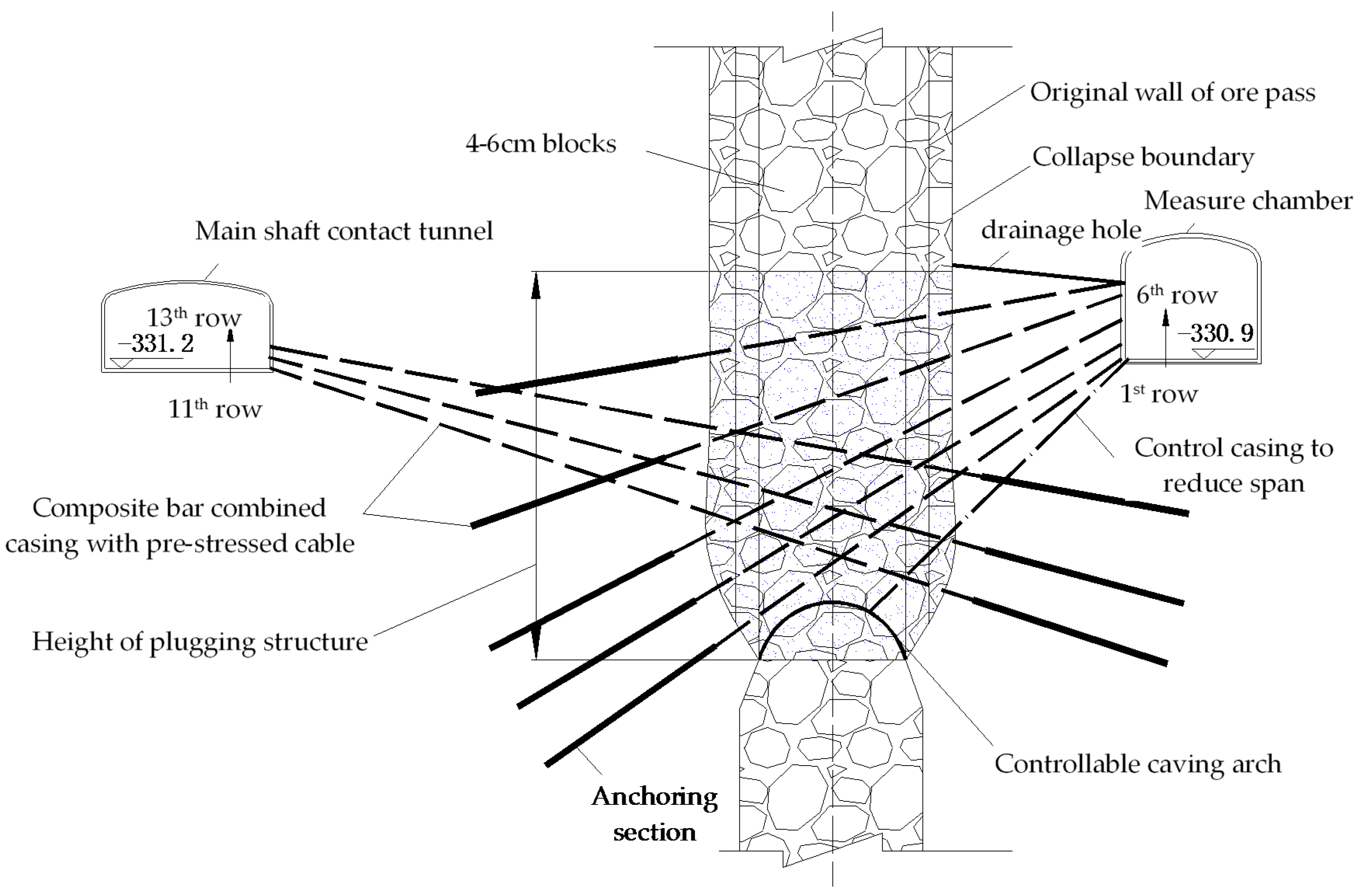
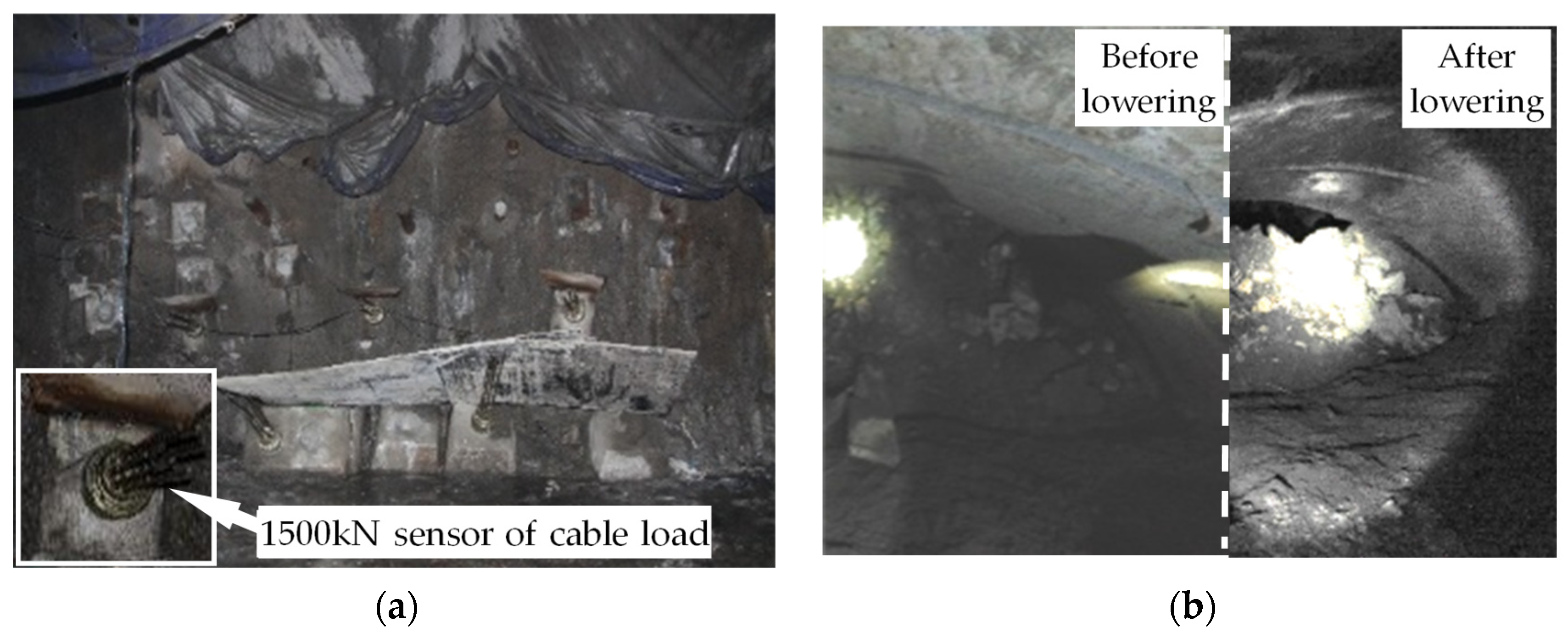

© 2018 by the authors. Licensee MDPI, Basel, Switzerland. This article is an open access article distributed under the terms and conditions of the Creative Commons Attribution (CC BY) license (http://creativecommons.org/licenses/by/4.0/).
Share and Cite
Chen, H.; Yu, S.; Wang, Z.; Yuan, Y. A New Plugging Technology and Its Application for the Extensively Collapsed Ore Pass in the Non-Empty Condition. Energies 2018, 11, 1599. https://doi.org/10.3390/en11061599
Chen H, Yu S, Wang Z, Yuan Y. A New Plugging Technology and Its Application for the Extensively Collapsed Ore Pass in the Non-Empty Condition. Energies. 2018; 11(6):1599. https://doi.org/10.3390/en11061599
Chicago/Turabian StyleChen, He, Shibo Yu, Zhixiu Wang, and Ye Yuan. 2018. "A New Plugging Technology and Its Application for the Extensively Collapsed Ore Pass in the Non-Empty Condition" Energies 11, no. 6: 1599. https://doi.org/10.3390/en11061599




